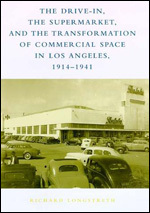March 31, 2009 Categories: Reviews
The Drive-In, The Supermarket, and The Transformation of Commercial Space in Los Angeles, 1914-1941
1999. MIT Press. 266 pp. $92.50
Richard Longstreth’s admirably concise history of now-commonplace building types covers more ground than its own title gives it credit for. He carries the story up into the 1950s, and includes less obvious centers of innovation including Houston, Kansas City, Long Island, and Washington, DC.

If you want a condemnation of “sprawl” and everything that led up to it, look elsewhere. Longstreth observes that Frank Lloyd Wright’s “Broadacre City” was astonishingly prescient as to the look of latter-day shopping centers, but he’s less interested in visions and visionaries than in the pragmatic merchants and speculators who inched their way from one adaptation to another on the way from the pedestrian-centered city to the automobile-centered metropolis.
The first step was to break the street wall. But it wasn’t thought of that way. “Filling stations” had to get gas and oil into cars somehow. Putting pumps at the curb was problematic for many reasons; putting them on the alley made it hard to attract customers; putting them indoors would be at best cumbersome and expensive. Therefore “property frontage was left open so that motorists could pull off the street and maneuver on the premises. …Since the building needed to be no more than an enclosed kiosk, it was easily located back from the street.” {7, 8} And so it all began. If anyone had the idea that they were making a major departure in urban design, Longstreth doesn’t mention it. For decades to come, the idea of off-street parking didn’t catch on.
Following quickly behind, around 1914 the Washburn-Walker Company put up the first “super service station,” with six bays fronting a courtyard of buildings for “lubrication, body cleaning and polishing, crank-case cleaning, battery repairs, tire repairs, and accessories.” {10} And all this three full miles from downtown LA on Western Avenue. “The most prominent feature was an ornate, freestanding canopy sheltering rows of gasoline pumps and visually functioning as a gateway to the entire complex. This practice of architecturally addressing the street continued throughout the decade.” It still seemed like the respectable thing to do. {14} The most successful design came to be an L-shape located on a corner lot.
From the super service station it wasn’t a big step to the drive-in market — basically a three-sided courtyard open to the street, containing a variety of small independently owned stores, and often located on a main artery far from other businesses. The author quotes an advertising agent of 1929: “Distance is a negligible consideration; the automobile is a convenient shopping basket.” {38} It’s worth noting that locally owned stores saw the drive-in as a way of combating the big chain stores. {41} Every now and then second-story offices or apartments were tried.
If you’re thinking it’s hard to appreciate all this without pictures, rest assured that the book itself more than satisfies this desire — an especially important function since most of the places discussed have long since disappeared, overrun by the automotive economy they pioneered.
Superseding drive-in markets during the 1930s were supermarkets, which originated simultaneously in several cities. Supermarkets were designed for low prices, high volume, and minimal overhead (self-service); all this meant a parking lot was a necessity. They didn’t look like the drive-ins; much of their innovation was internal; but they satisfied the appetite drive-ins had created for one-stop shopping by car.
For the time being, writes Longstreth, “the supermarket reclaimed the street. Frontality regained the importance it had had before the advent of the drive-in concept; but now this arrangement was devised to attract the eye of the passing motorist more than that of the pedestrian.” {81} Ralphs was the dominant player and LA pioneer of the form. Its innovations included open, nonhierarchical space and a single checkout stand. (In conventional stores or drive-in markets the customer had to make her purchases department by department). Once again, local owners paved the way; the Safeway chain, for one, long resisted larger stores.
When Ralphs began a second store-building campaign in 1935, it drew on the work of architect Stiles Clements, who went for a streamlined look on all sides. “Indeed, new units no longer possessed a front in the traditional sense….each store was planned to be seen from all sides so that it would not just stand out as a landmark for motorists approaching some blocks away, but at closer range, would seem accessible and inviting.” {117-8}
Meanwhile the drive-in neighborhood shopping center was catching on. Its compactness appealed to contemporary planners Clarence Stein and Catherine Bauer. But its implications went far beyond. “Pragmatism guided the development,” concludes Longstreth. “Yet the collective results were revolutionary.” {180} No doubt the road back will be the same.
#
